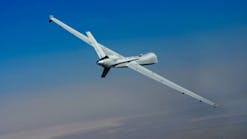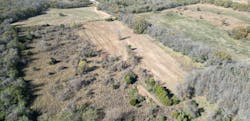The EPA has stepped onto the airfield with requirements to reduce emissions and the FAA's plan to assist airports may not spread to airlines, causing a buzz about the proposed program.
October 2004
One important topic discussed at the 2004 GSExpo was the EPA designating certain metropolitan areas as "nonattainment" areas where emissions need to be reduced and how through its Vision 100 Reauthorization Bill, the FAA plans to assist airports in reducing emissions through the acquisition of new "green" ground support equipment. This initiative is called the VALE (Voluntary Airport Low Emission) Program and offers funding to commercial service airports located in nonattainment or maintenance areas. These regions are in "nonattainment for so called criteria pollutants which would be 'at least ' one of the major pollutants like nitrous oxide, sulfur dioxide and particulate matter," says Roger Hooson, senior transportation planner for San Francisco International Airport. "A majority of major cities [and] major urban areas around the country are likely to be out of attainment," he continues. The airports in these areas will need to create plans to reduce their emissions and VALE is one of the programs to help them do that through GSE and other airport-related vehicles and equipment.
Based on the ILEAV (Inherently Low Emission Airport Vehicle) Pilot Program (covered by Michelle Garteson in GSM's Feb. 2003 issue) which had 10 airport participants, VALE will increase percentages of funding available under Airport Improvement Program (AIP) and Passenger Facility Charges (PFC) grants, while restricting eligibility. VALE will also offer emission credits granted by the EPA and the state or local air quality authority.
Paying for Vehicles/Infrastructure
Under VALE, the airport authority will get 75 to 95 percent of the additional
cost of the cleaner vehicle and up to 100 percent of the additional cost
of the infrastructure (compared to the 50 percent rates under ILEAV). However,
as it is currently written, VALE would exclude tenant-owned projects when
using AIP funds. Hooson says that San Francisco International Airport's
ILEAV grant allowed the purchase of vehicles and chargers owned by others. "That
was a key part of our project in the ILEAV grant, at least half the vehicles,
half the value of our grant was for airline owned or other tenant vehicles," says
Hooson, who believes VALE restrictions could present a problem for other
airports in a similar position.
PFC grants, the other funding option under VALE, may possibly allow tenant/airline owned vehicles and infrastructure, but Hooson sees a problem with PFC funds because many airports, including his own, have PFCs currently in place which are fully committed for the next few years to pay for major capital expansions that have already taken place or are pledged to pay debt service. "Many airports couldn't even use PFCs in the near-term, so they'd be forced to use AIP funds," explains Hooson.
In other instances, VALE will fund projects not covered under ILEAV such as gate electrification, hydrant fuel system upgrades and some power plant upgrades, but the emphasis will still be on airport ownership, points out Hooson.
Banking your Credits
For an airport to obtain VALE funds, the state or local air quality agency will need to provide emission credits for alternative power vehicles and sources. Although the credits will allow airports to avoid additional mitigations for future capital improvement projects, the process may be time consuming. "There may not be a requirement that the air quality agencies follow through in an expedited fashion with issuing these credits," says Hooson. "And also if airports have already undertaken voluntary steps on their own or the state has some stringent regulations in place, like [we do in] California, then we would qualify for fewer credits."
As a representative of the industry working with the FAA to improve VALE, Hooson has mixed reviews for the program, "we're certainly interested in any new grant program of this sort because we've been reducing emissions here for quite a number of years. It's a corner stone of the airport's policy to do that. We just want to be sure that the program is really going to be useful to all our tenants and that we'll be able to reduce emissions, because it does have wide applicability among the interested parties here at SFO."
Workshopping VALE
In September, a series of educational seminars about VALE were held throughout California. These VALE Airport Workshops provided an overview of VALE (as
it currently stands), information about how the program will affect California
airports, potential funding, clean fuel technologies and how to prepare for
the VALE program. "Our hope is that these workshops (concept) will
be used in other states," says Jon Van Bogart from CleanFUEL USA/Delta
Liquid Energy, a sponsor of the workshop, "as there are more
than 85 Clean Cities around the country."
William Elrick, an airport alternative fuels consultant, reports the meeting was very well received, "participants were pleased to have early notice of the VALE program (official FAA release is not scheduled until early October) and to learn of the new potential funding opportunity." Representatives from Clean Cities Programs (primary sponsor), airports, local air pollution control districts and air quality management districts, California Air Resources Board (Sacramento), California Energy Commission, local fuel providers, airport environmental consultants and local government attended the workshop and brainstormed about the big picture. "All seemed to agree that air quality will be THE pressing issue facing airports in the future," continues Elrick.
"We [California airports] compete fiercely for passengers," says Rick Ruvlol, from San Francisco Clean Cities Coalition, "but when it comes to clean air and energy security we work together as one team and do everything we can to support each other. This meeting was a reflection of that and we are excited about a possible new funding source to help us achieve those goals."
The FAA has received feedback about VALE from many interested parties, including Airports Council International and American Association of Airport Executives. "The airports are also asking for a conference call with the FAA and EPA," says Hooson, "to discuss the workability of the grant program further," which means VALE may still be evolving. One thing is clear, however, the switch to emission reducing and environmentally friendly GSE is gaining momentum in the industry.
For more information on VALE or to find out how to host a workshop in your area contact:
William Elrick
Alternative Fuels Consultant
[email protected]
410-646-4505
Jon Van Bogart
CleanFUEL USA
[email protected]
805-239-0616
Roger Hooson
Clean Air Vehicle Coordinator
[email protected]
650-821-6511




